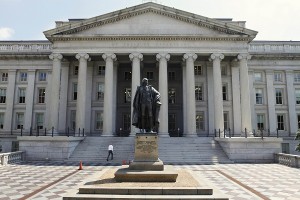WASHINGTON — The budget deficit for the current year is projected to come in well below what was estimated just a few months ago, according to a government study released Tuesday.
The Congressional Budget Office cites higher tax revenues and better-than-expected bailout repayments by mortgage giants Fannie Mae and Freddie Mac as the key reasons for the improved outlook. The budget office now predicts a 2013 budget deficit of $642 billion, more than $200 billion below its February estimate. This year’s shortfall would register at 4 percent of the economy, far less than the 10.1 percent experienced in 2009 when the government ran a record $1.4 trillion deficit.
Last year’s deficit was $1.1 trillion, capping four consecutive trillion dollar-plus deficits during President Barack Obama’s first term. Obama inherited an economy in recession, which stunted tax revenues for several years.
The deficit picture is expected to continue to improve next year and beyond, with the 2015 deficit now projected at $378 billion, just 2.1 percent of the economy. All told, the budget office predicts deficits over the coming decade of $6.3 trillion, down $618 billion from earlier projections.
The CBO report comes as Washington has again hit budget gridlock after enacting a $600 billion-plus tax increase on upper-bracket earners in January. The report could sap momentum from further deficit-cutting efforts since the shortage will fall below 3 percent of the economy for several years, levels considered by many economists to be sustainable.
The improved budget picture also means that the deadline for increasing the government’s borrowing cap has been postponed until October or November. It had been expected that lawmakers would have had to act this summer to increase the so-called debt limit.
One of the reasons for the burst of additional income tax revenues, the budget office says, is that upper-income taxpayers claimed more income late last year in order to avoid paying the higher tax rates enacted in January.
The agency predicts that publicly held U.S. debt, currently estimated at 75 percent of gross domestic product, will shrink to 71 percent of gross domestic product over 2017-2019 before inching up again at decade’s end. As recently as 2007, the budget office notes, federal debt was just 36 percent of GDP.
The current federal debt exceeds $16 trillion, almost double what is was at the end of 2006.
“Such high and rising debt later in the coming decade would have serious negative consequences,” CBO says in the report, citing longstanding arguments that high deficits and debt reduce national saving and investment and increases the risk of a full-blown fiscal crisis.
One of the reasons for lower deficits is that gridlock in Washington has meant that mandatory, across-the-board cuts have begun to take effect. The cuts are expected to curb spending by about $80 billion in the 2013 budget year ending Sept. 30.
CBO is the nonpartisan agency that does economic and budget analysis for Congress.
